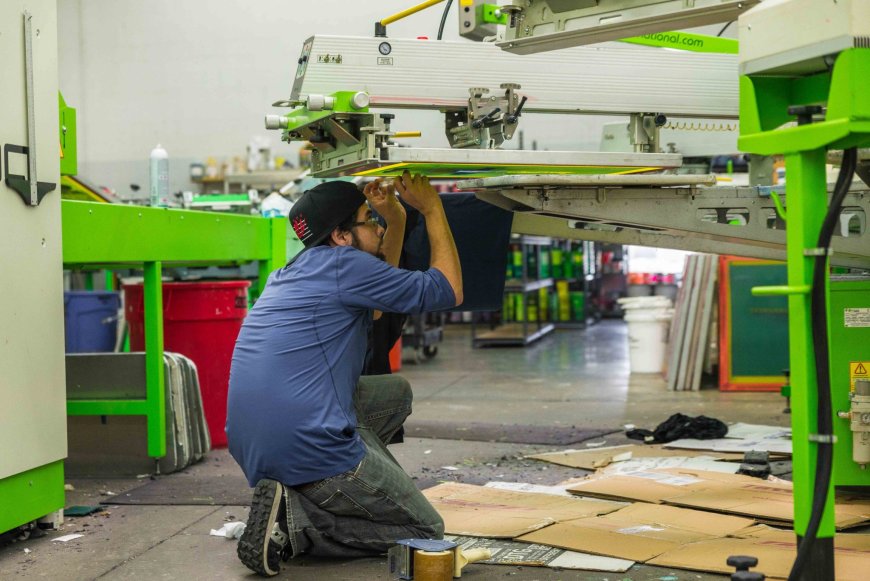Is Screen Printing Environmentally Friendly Possible?

Screen printing is a practical method for producing attractive designs on textiles like garments and screen printing leads to increasing environmental issues. More and more people are asking whether it's possible to print screens in an environmentally friendly way as knowledge of environmental problems grows. After reviewing the situation, we'll discuss making screen printing eco-friendly.
What is Environment-Friendly Screen Printing?
Screen printing is environmentally friendly and does not threaten the environment due to its extensive waste production and use. Reusing and recycling materials makes them more environmentally friendly and helps screen printers operate more safely. It is a pollution-free method of maintaining the environment.
Water-Based vs. Plastisol Ink in Screen Printing
Water-based inks, which use dyes suspended in water, can make screen printing environmentally friendly. They are less successful on dark materials since the color of the garment might alter the ink's look, but they are ideal for bright patterns on light-colored clothing. Large quantities and not all materials are suitable for water-based inks. Water-based discharge inks work better for soft prints on dark clothing.
Environment-friendly Screen Printing Inks
Environmentally friendly screen printing inks are becoming standard procedures for businesses trying to maintain longevity as ecological awareness rises. With their advantages, soy-based, water-based, and UV-curable inks are well-liked environment friendly options.
Soy Based Inks
Environment friendly soy based inks, made from soya beans, are used in place of chemical based inks. Bright colors are created, and air pollution is reduced by producing less volatile organic chemicals. Despite their reduced environmental impact, concerns concerning soybean production's water and carbon footprints persist. In general, using them for printing is more environmentally friendly.
Water Based Inks
Water-based inks are increasingly popular for fabric printing due to their soft feel prints and ease of use. They offer vibrant colors, durability, and a safer work environment by eliminating harmful chemicals. Their growing use reflects their appeal to both artists and manufacturers.
UV Inks
UV inks can dry quickly when visible to UV light, speeding up production and reducing costs. They don’t contain chemicals, which cuts down on harmful emissions. However, caution is needed due to potential health risks from UV curing agents used in the process.
Each type of ink offers environmental benefits but requires careful consideration of their overall impact and safety.
The Advantages of Selecting Water-Based Inks for Screen Printing Projects
1. Versatility: For printing on a variety of surfaces, such as labels, paperwork, canvas, and clothing like T-shirts, hoodies, and tote bags, water-based inks are perfect. They function well with textiles like polyester, cotton, and polycotton blends.
2. Soft Finish: These inks produce a minimal or soft "hand," giving prints a smooth, seamless feel similar to direct-to-garment (DTG) printing.
3. Ironing Safety: Unlike plastisol prints, water-based prints can be safely ironed over without affecting the design.
4. Vibrant Colors: Water-based inks result in brighter, more vibrant prints once cured, enhancing the visual appeal of the designs.
5. Durability: Water-based prints often outlast the fabric, maintaining their quality and appearance even after multiple washes.
6. Lightweight Designs: Large, detailed prints with water-based inks feel light and thin, adding minimal bulk to the garment.
7. Breathability: The ink's fabric penetration improves ventilation and comfort.
8. Environmental Safety: Compared to other ink kinds, water-based inks are non-toxic, lead-free, and environmentally safer.
9. Easy Clean-up: Water-based ink-using equipment doesn't require harsh chemicals to clean; it can be done with ordinary water, making it safe to put down the drain.
Can a Screen Printer Be Environmentally Friendly?
Being an entirely environmentally friendly screen printer is an impossible goal, but screen printers can do plenty of things to make their impact less harmful. To do this, every stage of the screen printing procedure must be examined.
Clothing that you already own or thrifted is the most environmentally logical. There are then ecologically friendly and sustainable shirts available on the market. With a quick internet search, finding a logically friendly shirt is easy. Several businesses have created biodegradable and environmentally friendly items. Look through their selection to select the ideal material for your business.
The Verdict:
Although it can be difficult to make screen printing eco-friendly, there are ways to make it considerably better. Using water- or soy-based inks, recycling materials, and picking environmentally-friendly garments can reduce environmental harm. Screen printers can help create a more sustainable industry and reduce environmental impact by choosing these greener options. With thoughtful choices, it’s possible to be practical and environmentally responsible.












